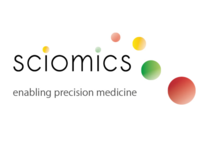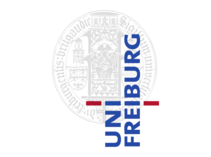Epigenetic biomarkers and nanopore technology for advanced diagnostics in personalized medicine
Stanka Matic - Postdoc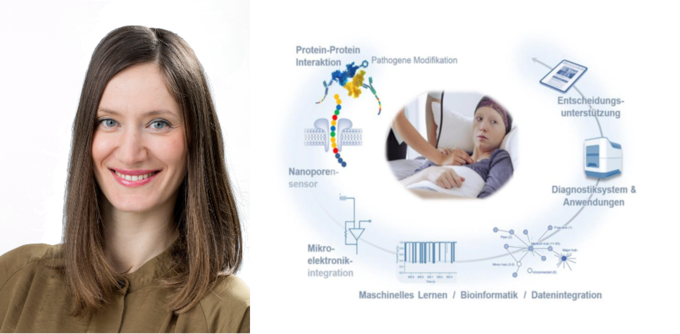
stanka.matic@uniklinik-freiburg.de
+49 761 270 82480
ORCID: 0009-0009-3941-0748
Web of Science ResearcherID: LHA-4440-2024
Aim of the project: To generate new knowledge about the epigenetic changes during cancer therapy and to use this knowledge to develop improved diagnostic and therapeutic strategies for better patient outcome.
Project description: Our project is a part of nanodiag_BW Cluster4Future that brings together multidisciplinary research teams from academic institutions and industry in Baden-Württemberg. The cluster aims to enhance existing and develop new nanopore technologies for the detection of protein post-translational modifications (PTMs) in clinical samples. Our group investigates epigenetic biomarkers, such as DNA methylation and PTMs in extracellular vesicles (EVs), which are applicable as liquid biopsy biomarkers, and have a potential to improve identification of resistance by immune and epigenetic therapies in cancer patients. The vision of the project is to establish a basis for the application of nanopore technology in liquid biopsy.
Funding and collaborators:
Deciphering the epigenetic landscape of extracellular vesicles: The impact of tetraspanins on DNA and histone modifications
Rihab Ksouri - PhD Student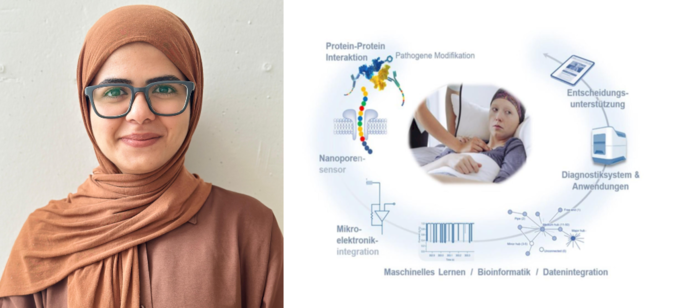
rihab.ksouri@uniklinik-freiburg.de
+49 761 270 82180
Aim of the project: To advance the understanding of epigenetic modifications on the extracellular vesicle level, which are occurring during cancer treatment. Thus, leverage this insight to create enhanced diagnostic and therapeutic approaches, ultimately improving patient outcomes.
Project description: My project is also part of the nanodiag_BW Cluster4Future, which brings together multidisciplinary research teams from academic institutions and industry in Baden-Württemberg. The cluster aims to enhance existing and develop new nanopore technologies for detecting protein post-translational modifications (PTMs) in clinical sample. My current investigation focuses on the role of tetraspanins in epigenetic modifications within extracellular vesicles (EVs), particularly DNA methylation and histone modifications. EVs, which can originate from diverse sources, are loaded with varying contents (proteins, nucleic acids, etc.) by their host cells, resulting in heterogeneous cargo based on their sources and pathological behaviour. To address this, our objective is to develop an innovative methodology for distinguishing, colocalizing, and segregating EV-associated DNA and histones, whether embedded within EVs or associated with a protein corona, using techniques such as nFCM, NTA, and other novel methodologies.
Analysis of diagnostic and predictive value of a selected biomarker panel for prostate cancer
John Atanga - PhD Student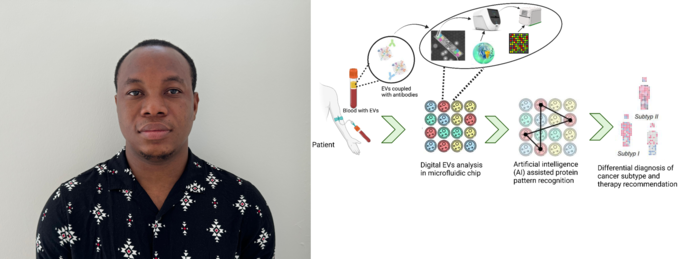
john.atanga@uniklinik-freiburg.de
+49 761 270 83090
Aim of the project: To develop next-generation liquid biopsy assay for early diagnosis of prostate cancer utilizing molecular signatures on extracellular vesicles
Project description: The early detection of cancer and the identification of therapy resistance are crucial for improving the chances of survival for affected individuals. The EV-Surf project is currently investigating a new approach to cancer diagnosis using extracellular vesicles (EVs) isolated form the blood of patients.
By leveraging advancements in protein analytics, such as miniaturization through microfluidics, digital assay technology, and AI-based protein pattern recognition, the project aims to develop a highly accurate diagnostic assay. This innovative technique focuses on analyzing EVs, which carry specific cancer-related proteins on their surface. The initial focus is on prostate cancer, serving as an illustrative example to demonstrate how the limitations of current blood-based assays can be overcome through digital analysis of EVs.
Once successful for prostate cancer, the EV-Surf technology can be extended to other diseases. For patients, the introduction of the EV-Surf blood test eliminates the need for painful tissue biopsies. In the event of a positive test, it enables the immediate identification of the specific subtype of cancer, facilitating prompt initiation of effective treatment.
Funding and collaborators:
Characterization of extracellular vesicles by fluorescent Nanoparticle Tracking Analysis
Gonzalo Bustos - PhD student
gonzalo.salvador.bustos.quevedo@uniklinik-freiburg.de
+49 761 270 82170
ORCID: 0000-0001-6956-6609
Aim of the project: Differentiate between EV and non-EV particles in biofluids by using fluorescence mode by Nanoparticle Tracking Analysis.
Project description: Focusing on developing an innovative method for distinguishing between extracellular vesicles (EVs) and non-EV particles in blood samples using nanoparticle tracking analysis (NTA). Blood samples are a convenient and reliable way to gain insights into both healthy and pathological conditions. However, a significant challenge in analyzing blood samples is differentiating EVs from other vesicles, such as lipoproteins (HDL, LDL, VLDL, and chylomicrons), which share similar size and density characteristics with EVs. To ensure accurate results, we are currently working on quantifying them using NTA. By employing specific markers and antibodies labeled with fluorophores, we can differentiate and measure distinct populations of EVs and lipoproteins as separate entities.
In summary, our project aims to isolate EVs from the blood of both healthy individuals and patients with prostate cancer using SEC. We then characterize these particles using NTA, allowing us to discriminate between EVs and non-EV particles. This advancement holds promise for optimizing diagnostics in prostate cancer.
Funding and collaborators:
Dr. Gerhard Pütz - Institute for Clinical Chemistry and Laboratory Medicine
Extracellular vesicles in retinal vasoproliferative diseases
Melanie Schwämmle - PhD student
melanie.schwaemmle@uniklinik-freiburg.de
+49 761 270 40973
ORCID: 0000-0002-9040-3879
Aim of the project:
1. Investigate the role of Müller cell-derived extracellular vesicles in retinal vasoproliferative diseases
2. Characterize the EV-profile of blood samples from patients suffering from diabetic retinopathy
Project description:
My PhD thesis focuses on the pathophysiology of retinal vasoproliferative diseases, especially on the involvement of extracellular vesicles. I am mainly working with two sample types: Müller cells (funded by the Else-Kröner-Fresenius Foundation) and blood samples from diabetic patients (funded by Bayer – Förderprogramm für Augenheilkunde).
Project 1: Müller cells, the major glial cells in the retina, interact with various retinal cell types, playing a crucial role in retinal function and health. However, how Müller cells communicate with other retinal cells is not well understood. We are researching the role of extracellular vesicles (EVs), which can transport proteins, nucleic acids, and lipids between cells, in mediating this communication in both healthy and diseased retinas.
Project 2: Diabetic retinopathy (DR) is one leading cause of vision loss in patients suffering from diabetes mellitus. Since many patients do not show any symptoms until later stages of the disease, biomarkers that help to detect ophthalmologic complications early in the disease progression could improve treatment strategies. Therefore, we aim to investigate the EV-profile of blood samples from patients suffering from different stages of DR.
Funding and collaborators:
PD Dr. Felicitas Bucher – https://www.uniklinik-freiburg.de/augenklinik/fol/expo/agbucher.html
EVs from organoids as a tool for therapy response monitoring
Anna Palchikova - WiHi student
anna.palchikova@uniklinik-freiburg.de
+49 761 270 82450
Aim of the project: To understand the molecular and genetic changes that occur in response to second-line therapy in prostate cancer, with the ultimate goal of identifying biomarkers that can guide treatment decisions and improve patient outcomes.
Project description: My project aims to identify biomarkers that correlate with the response to second-line therapy in prostate cancer. To achieve this, we analyse extracellular vesicles (EVs) released from organoids and circulating in the blood of mice with human prostate cancer xenografts. These organoids are treated with Enzalutamide and Dihydrotestosterone, and the EVs will be studied for their surface proteins, RNA, and DNA content.
Funding and collaborators:

Group leader
Prof. Dr. rer. nat. Irina Nazarenko
+49 (0) 761 270 82100
+49 (0) 761 270 82030
irina.nazarenko@uniklinik-freiburg.de
Institute for Infection Prevention and Control
Medical Center – University of Freiburg
Breisacher Straße 115 b, 79106 Freiburg im Breisgau, Germany
X (formerly Twitter): @nazarenkoteam
LinkedIn: Extracellular vesicles research group - Prof. Irina Nazarenko
Instagram: @nazarenkoteam
Assistance
Susanne Görner
Phone: +49 (0) 761 270 82390
Fax: +49 (0) 761 270 82030
susanne.goerner@uniklinik-freiburg.de










